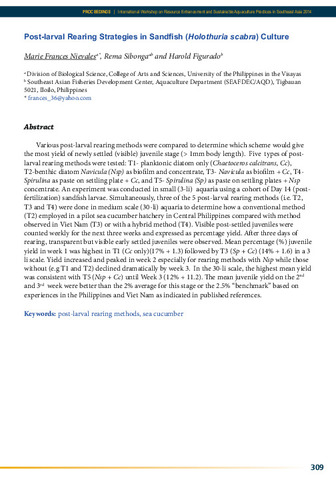Post-larval rearing strategies in sandish (Holothuria scabra) culture
Share
abstrak
Various post-larval rearing methods were compared to determine which scheme would give the most yield of newly settled (visible) juvenile stage (> 1mm body length). Five types of postlarval rearing methods were tested: T1- planktonic diatom only (Chaetoceros calcitrans, Cc), T2-benthic diatom Navicula (Nsp) as biofilm and concentrate, T3- Navicula as biofilm + Cc, T4Spirulina as paste on settling plate + Cc, and T5- Spirulina (Sp) as paste on settling plates + Nsp concentrate. An experiment was conducted in small (3-li) aquaria using a cohort of Day 14 (postfertilization) sandfish larvae. Simultaneously, three of the 5 post-larval rearing methods (i.e. T2, T3 and T4) were done in medium scale (30-li) aquaria to determine how a conventional method (T2) employed in a pilot sea cucumber hatchery in Central Philippines compared with method observed in Viet Nam (T3) or with a hybrid method (T4). Visible post-settled juveniles were counted weekly for the next three weeks and expressed as percentage yield. After three days of rearing, transparent but visible early settled juveniles were observed. Mean percentage (%) juvenile yield in week 1 was highest in T1 (Cc only)(17% + 1.3) followed by T3 (Sp + Cc) (14% + 1.6) in a 3 li scale. Yield increased and peaked in week 2 especially for rearing methods with Nsp while those without (e.g T1 and T2) declined dramatically by week 3. In the 30-li scale, the highest mean yield was consistent with T5 (Nsp + Cc) until Week 3 (12% + 11.2). The mean juvenile yield on the 2nd and 3rd week were better than the 2% average for this stage or the 2.5% benchmark based on experiences in the Philippines and Viet Nam as indicated in published references.
Penerangan
Abstract only.
Suggested Citation
Nievales, M. F., Sibonga, R., & Figurado, H. (2015). Post-larval rearing strategies in sandish (Holothuria scabra) culture. In M. R. R. Romana-Eguia, F. D. Parado-Estepa, N. D. Salayo, & M. J. H. Lebata-Ramos (Eds.), Resource Enhancement and Sustainable Aquaculture Practices in Southeast Asia: Challenges in Responsible Production of Aquatic Species: Proceedings of the International Workshop on Resource Enhancement and Sustainable Aquaculture Practices in Southeast Asia 2014 (RESA) (p. 309). Tigbauan, Iloilo, Philippines: Aquaculture Department, Southeast Asian Fisheries Development Center.

